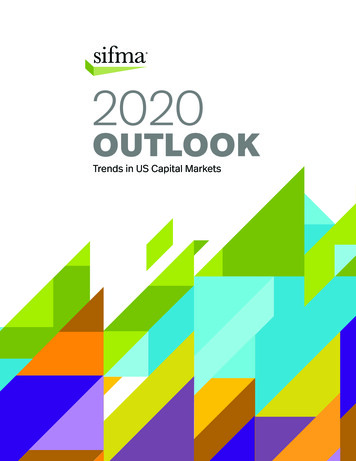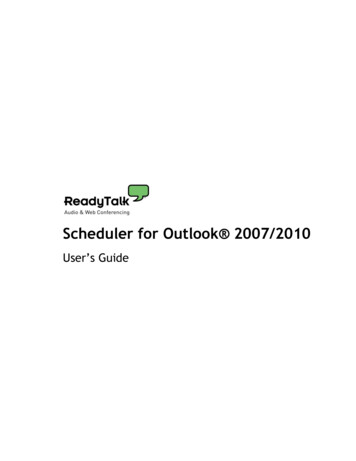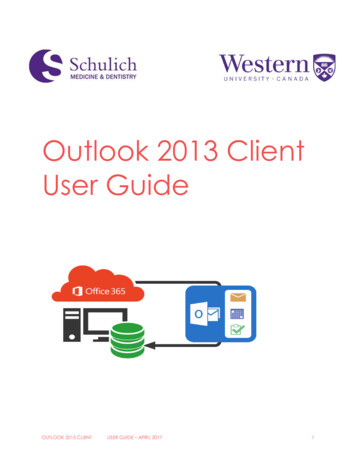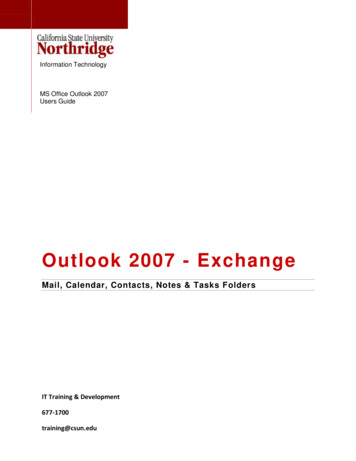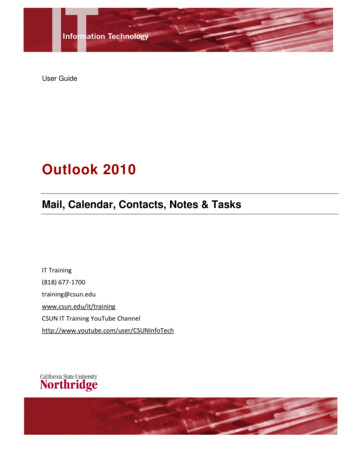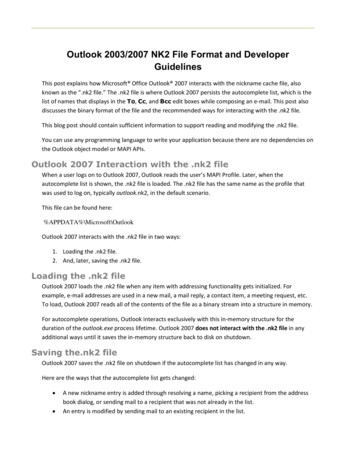
Transcription
The Industry OutlookSIFMA InsightsThe 2022 Operations Conference & Exhibition DebriefPerspectives & Key Themes from Market ParticipantsMay 2022Recently, SIFMA hosted our annual Operations Conference & Exhibition. With three days of presentations andevents and over 750 participants, we gained insights into top-of-mind topics for market participants. Inside this note,we recap just some of what was seen and heard, including: The Industry Outlook – top sector and industry priorities/themes with survey, new normal for officeTransition to T 1 Settlement – what is different this time, the playbook for implementation, why not T 0;includes snapshots on the impact heatmap and timelines, as well as survey and audience polling resultsThe Regulatory View – remote work supervision, digital assets/cryptocurrency, thoughts from marketparticipants on the aggressive regulatory agenda ( 50 rule proposals from the SEC alone)The ESG Perspective – SEC climate disclosure, survey on ESG investing and underwritingMore on Market Themes – digital assets/cryptocurrency, blockchain technology potential use cases,operational resiliency risks identified, cybersecurity, U.S. Treasury marketsTo see details from topics SIFMA has covered throughout the year, please see SIFMA Insights at (list of Insightsreports in the Appendix of this note): www.sifma.org/insightsSIFMA InsightsPage 1
The Industry OutlookContentsThe Industry Outlook . 4Top Sector Themes . 4Market Touchpoint: Industry Themes . 6The New Normal for the Office . 7The Transition to T 1 Settlement . 9What Is Different This Time? . 10The Playbook for Implementation . 11Why Not T 0? . 15Audience Polling Results . 16Pre-Conference Survey Results . 17The Regulatory View . 19Remote Work Supervision . 19Digital Assets/Cryptocurrency . 19Thoughts from Market Participants . 20The ESG Perspective . 22SEC Climate Risk Disclosure . 22Market Touchpoint: ESG . 25More on Market Themes . 26Digital Assets/Crypto Currencies . 26Market Touchpoint: Crypto . 30Market Touchpoint: Blockchain Technology . 31Market Touchpoint: Operational Resiliency . 33Cybersecurity . 34US Treasury Markets . 35Appendix: SIFMA Insights Research Reports . 36Author . 38SIFMA InsightsPage 2
The Industry OutlookSIFMA Insights can be found at: https://www.sifma.org/insightsSIFMA is the leading trade association for broker-dealers, investment banks and asset managers operating in the U.S. and global capital markets. Onbehalf of our industry’s nearly 1 million employees, we advocate on legislation, regulation and business policy, affecting retail and institutional investors,equity and fixed income markets and related products and services. We serve as an industry coordinating body to promote fair and orderly markets,informed regulatory compliance, and efficient market operations and resiliency. We also provide a forum for industry policy and professionaldevelopment. SIFMA, with offices in New York and Washington, D.C., is the U.S. regional member of the Global Financial Markets Association (GFMA).For more information, visit http://www.sifma.org.This report is subject to the Terms of Use applicable to SIFMA’s website, available at http://www.sifma.org/legal. Copyright 2022SIFMA InsightsPage 3
The Industry OutlookThe Industry OutlookTop Sector ThemesTo set the scene of the conference, we surveyed attendees and select SIFMA members on the top memberidentified industry priorities for the next two years. As various perspectives arose during the week, it was a reminderof the importance of market participants coming together to discuss best practices as well as pain points that theindustry must work together to overcome.A number of the identified priorities addressed the transition to T 1, automation/digitization, andefficiencies/optimization, as detailed below.Survey Question: Please list your top three operations & technology priorities for the next two years.Top Operations & Technology Priorities for the Next Two .0%6.0%Talent2.6%2.6%2.6%Risk Mgt3.4%Digital Assets3.4%Cost ulationsNew Tech (AI,Cloud, DLT)Client tizationT 10%Source: SIFMA Insights pre-conference survey1Note: T 1 refers to the shortening of the settlement cycle; AI artificial intelligence, DLT distributed ledger technology; Talent refers to recruiting,retaining, and managing employees; Risk Mgt risk management1The pre-conference survey was in the field from May 3-13, with over 40 respondents in totalSIFMA InsightsPage 4
The Industry Outlook T 1 – acceleration of trade settlements; focus on the transition; readiness; supporting the move, updatesneeded for the move; and general references to T 1 Automation/Digitization – reduce manual tasks/workflows/processes; straight-through processing (STP);Application Programming Interfaces (API); for account opening, alternatives, cashiering, client onboarding/know your customer (KYC), marketing, banking strategies, forms/data transfer, clientcommunications, physical securities Efficiencies/Optimization – in general for platforms, processes, workflow, controls, and data efficiencies;advisor productivity; architecture alignment to reduce redundancy in tools; build efficient/secure connectivitybetween asset owners and service providers across multiple operational functions; increased use of datadriven solutions; move to hosted solution for back office applications; scale; streamline front to backworkflows; transformation, upgrades, replacement; trading platforms Client Experience – focus on, enhancing; onboarding; expanding offerings, offering more self-serviceoptions; improve end investor experience New Tech (AI, Cloud, DLT) – blockchain/distributed ledger technology (DLT); cloud migration; incorporatingartificial intelligence (AI) technology; generally use fintech to create transformational change or findefficiencies in processing Regulations – in general handling changes, compliance, impacts from reg updates; dealing with Gensleragenda; remote work force supervision Cybersecurity Resiliency – infrastructure resiliency and modernization; platform stability Talent – recruiting, retaining, and managing employees; broadening skillsets of staff to create a moreflexible workforce; focus on human capital in post-COVID world Cost Reduction – cut costs; revenue/cost models in current inflationary and rising rate environment Digital Assets – asset servicing; crypto Risk Management – improve risk management, operations risk reduction through technology investment Other – claims management; create industry working groups at senior levels to help address industrychallenges across the operations spectrum; derivatives collateral; develop common operations software forthe financial industry; exception minimization; clearing; ISO 20022 migration; LIBOR; OCC Renaissance;private equity and alts; Schwab/TD Ameritrade integration; stock loan reporting; tax withholding due to 1446fSIFMA InsightsPage 5
The Industry OutlookMarket Touchpoint: Industry ThemesOur pre-conference survey sought to gauge respondents’ concerns around current geopolitical, economic andmarket events and trends. We highlight the following in respondents perspectives on key concerns: Cyberattacks ranked #1, with 48.8% of respondents extremely worried and 39.0% worried Even higher inflation #2, with 17.1% of respondents extremely worried and 46.3% worried A severe market decline was also a concern, with 39.0% of respondents each ranking it a 4 and 3 A real estate bubble burst remains one of the least concerning issues, 29.3% of respondents ranking this a 2Survey Question: How would you rate your level of concern about? (on a scale of 1-5 where 1 not at all, 5 extremely worried)How Worried Are You About:1 (Not at all)Cyberattacks12.2%Even higher inflation9.8%Central bank policies12.2%Market volatilitySevere market declineReal estate bubble bursts2.4%45 urce: SIFMA Insights pre-conference surveySIFMA InsightsPage 6
The Industry OutlookThe New Normal for the OfficeReturn to OfficeThe return to office conversation continues. Panelists and senior leaders have laid out a wide spectrum ofapproaches, ranging from no formally defined requirements to having defined requirements in tiered approaches: Fully remote Hybrid (2-3 days in the office) Fully in the officeAll of the approaches appear to work, but many firms and the industry as a whole having not yet landed on the“right” approach. Firms are remaining flexible, and employees have different views on establishing their workschedules. Some employees want to come into the office when they know other people will be there, while otherswant to spend more time working from home as they do not want to resume commuting for two hours. Firms arehosting corporate events or offering flexible commuting hours (allowing employees to avoid rush hour and then loginform home to finish the day) to entice people back into the office.Panelists also discussed the concept of returning to work with purpose. To drive value from an employee’s workday,they need to be synchronous when in the office. This holds true particularly across teams, but across theorganization as well (where applicable). While technology enabled employees to get business remotely duringCOVID, it does not replace a team getting together in a room and mapping out a project on a white board.In addition to building a resilient workforce, panelists spoke to the need to develop a fair work environment. Withhybrid schedules here to stay, firms will have employees with varied work schedules. Those employees workingremotely – whether permanently or on a specific day – will miss the water cooler conversations or the tap on theshoulder to work on an important project. Panelists indicated that managers need to ensure all employees feel theyare treated fairly and have equal opportunities for development and promotion, regardless of their work schedule.SIFMA InsightsPage 7
The Industry OutlookWar for TalentWe have all heard about the Great Resignation, leaving firms fighting to recruit and retain employees. Many in theindustry are struggling with talent management – sourcing, acquiring, and retaining. There is a war for talent acrossall industries, particularly for younger talent, and managers need to shift their thinking. The new generation ofprofessionals do not just automatically expect to be at the same firm for 20 years, those days are gone. Firms needto find ways to keep talent engaged and motivated if they want to keep them at their firms.Managers need to raise the skillset and profile of operations careers, as the new generation looks beyond traditionalroles. For example, one panelist told the story of his son’s college graduation. Not one of his son’s friends washeading to a traditional industry, instead opting for careers in startups, sustainability roles, or non-fungible tokens(NFT). The industry cannot afford to lose this new talent, nor lose existing employees.Panelists noted that we need to look beyond the Great Resignation and turn the lens inward. For a long time, theindustry focused on performance metrics and bonus numbers, but the younger generation looks beyond this. Theyare tech-enabled (almost from birth), well informed, and look beyond compensation when choosing where to work.Panelists indicated that the industry needs to adopt to new ways we work to attract and retain talent.SIFMA InsightsPage 8
The Transition to T 1 SettlementThe Transition to T 1 SettlementShortening the settlement cycle can mitigate risk, increase the overall efficiency of securities markets, and allow forbetter uses of capital. In late summer of 2020, DTCC started analyzing the potential move to T 1 settlement daysfrom T 2. DTCC indicated the move to T 1 from T 2 days in equities could reduce the VaR component of theclearing fund by approximately 40% at NSCC. 2 This would return capital to clearing participants and reduce risk inthe system.While a significant undertaking, this is not the first time the industry has had to work together to transition to ashortened settlement cycle. In 1993, the industry moved to T 3 days from T 5. In 2017, the industry moved to T 2days from T 3. What is different this time you wonder? The main difference in the move to T 1 from T 2 is that thistransition will be require a greater degree of process transformation as time frames are further reduced. Additionally,the SEC appears to be more forward leaning on the transition than when the industry moved from T 3 days to T 2.The industry has laid out a path to implement the move to T 1 by September 3, 2024.3 Panelists at our conferenceindicated that, in reality, this means the build out should largely be finalized by the end of 2023, in order to provideample time for testing to ensure market stability and resiliency. As such, 2022 has been labeled the year of impactanalysis and securing budgets and management buy in. 2023 appears to be the year of building and implementingchanges. Finally, 2024 will be the year of testing and then the launch:2022:2023:2024:Impact analysis; set budgets,secure management buy inBuild, implementchangesTesting, launch onSept. 32DTCC Depository Trust & Clearing Corporation, a post-trade financial services company providing clearing and settlement services. VaR Value atrisk, quantifies the extent of possible financial losses within a firm, portfolio, or position over a time period. NSCC National Securities ClearingCorporation, providing clearing, settlement, risk management, central counterparty services for U.S. equities (and more)3The industry has proposed Sept. 3, 2024 as the transition dateSIFMA InsightsPage 9
The Transition to T 1 SettlementWhat Is Different This Time?The consensus across the industry is that the transition to T 2 days from T 3 back in 2017 went seamlessly.Looking at the math – once again removing one day in the settlement cycle – may lead some to ask why is themove to T 1 days from T 2 so different. The move to T 2 days from T 3 was viewed as more of a tightening of thebelt. However, the move to T 1 days from T 2 is both a market structure and a technology compression event. Thistransition broadens what and who will be impacted. (Spoiler alert, all market participants will be impacted.) The T 1transition will fundamentally alter the way the industry does business across many processes and products, not justmake basic changes which can be accommodated by an acceleration of work schedules.As mentioned earlier, the main differences in the move to T 1 days from T 2 can be bucketed as: Behavioral process changes: Firms will need to look at how their organizational structure is set up. Theywill need to need to standardize, normalize, and share many of today’s manual processes. There will bechanges in processes and workflows on a global scale. This will require operations employees to rethinktraditional behaviors, for example looking at a piece of the workflow only one time per day. They will need todo an inventory of clients and vendors – are there firms that regularly do not send data in a timely manner?They will need to assess what causes exceptions, in order to eliminate them. They will need to changedocumentation related to settlement date (replacing T 2 specifically labelled, keeping it more generic forpotential future changes). They will need to open up technology support to be closer to 24/7. Buyside involvement: In terms of communications, retail and institutional investors will be treateddifferently. While retail investors themselves will need limited preparation, institutional investors need toknow now and to begin their own planning. They themselves need to make significant changes in theirsystems, processes, staffing, documentation, etc. for example, some firms do not currently affirm at all, letalone by 9:00 PM EST on trade date. There are some clients who have not embraced STP4. The changesbecome particularly significant for firms based on the West Coast of the U.S. or internationally, bringing in atime zone component. International participation: How will the move to T 1 in the U.S. synch up with the rest of the world? Whenthe U.S. moved to T 2 days from T 3, it was joining an earlier move by Europe to T 2. This time, the U.S.would be a first mover, along with Canada which has already indicated it will move in alignment with the U.S.The compression of settlement timeframe will bring time zone complications, as well as FX questions. Firms,particularly those with no U.S. based operations, will need to adjust staffing and processes to match U.S.East Coast timeframes. The industry will also be in dialogue and coordination with other internationalmarkets (particularly in the Americas) that have expressed interest in moving in alignment with the UStransition.Of note, panelists believe that other countries/regions will likely follow, given the size of the U.S. equitymarkets – the U.S. represents 41.6% or 49 trillion of the 117 trillion global equity market cap and is 3.8xthe #2 market, China, and 3.9x the #3 market, the EU. However, moves by other countries/regions areexpected to take time, potentially not by 2024.4Straight-through processing is an automated process done purely through electronic transfers with no manual intervention involvedSIFMA InsightsPage 10
The Transition to T 1 SettlementThe Playbook for ImplementationBefore designing the playbook for the transition to T 1, market participants first developed a heat map for activitiesand impacts. They assessed areas or topics requiring changes, identifying 24 key areas. These topics incorporate avariety of areas, including: processing timelines, documentation, funding, reference data, instructions, etc. Next,verticals were established in the following categories: process/technology, difficulty/complexity, timing, breadth ofimpact, dependencies, and costs/benefits. Each topic was then given a rating under each silo/category. Finally, atotal impact rating was assigned for each of the 24 topics, ranging from high (orange) to minimal (grey).This heat map matrix established 144 individual impact ratings ( topic x silo). The first thing one notices whenlooking at the matrix is that is a lot of orange, or high impact ratings! This visually shows how difficult the operationallift to successfully and safely transition to T 1 will be. Challenging but achievable, according to market participants.We highlight the following from the matrix (shown on the next page): Difficulty/complexity had the most orange ratings (high impact), 15/24, and no grey areas (minimal impact) Dependencies was the next highest vertical, with 11/24 oranges (high impact) and 11/24 yellows (moderateimpact) Costs/benefits had the least oranges (high impact), 7/24, but also no greys (minimal impact) The following topics had an aggregate dark orange T 1 rating, identifying them as the areas of highestimpact (which does not mean that the other areas are not difficult of impactful)oCoordinated processing timelineoInstitutional trade allocations/affirmationoErrors/failsoExternal documentation (ex: 10b-10s)oPrime brokerageoSecurities lendingoImpacts on derivatives marketsoTesting and migration (ex: timelines)oTime compression on cyclesSIFMA InsightsPage 11
The Transition to T 1 SettlementT 1 Impact HeatmapSIFMA InsightsPage 12
The Transition to T 1 SettlementLooking more closely at the playbook for implementation, market participants have laid out detailed timelines,bucketing tasks across the next three years into: 2022, Plan – the year of impact analysis and securing budgets and management buy inoThe industry playbook is already in process, with work being driven by SIFMA (led by SIFMA’sOperations & Technology Committee), the Investment Company Institute (ICI) and the DTCC,supported by DeloitteoAnalyze firm’s processes, workflows, staffing, etc., including a cost assessmentoGet buy in from senior management on the project workflow map, employee resources, and budgetnumbersoMeet with business partners to establish prioritization and attain employee resourcesoSet up a project management office to establish a communications infrastructure with seniormanagement and business partners; a two-way street so they can come to the operations team withquestions as wello Establish ownership and targets2023, Build – the year of building and implementing changesoSet up a project management structure and workflow map, a very detailed business plan – firmscannot report yellows/reds as the year progresses, they need greens across the board oBuild out system, process, workflow, and staffing changes needed for the transitionoBuild out the test processesoBe prepared for things that will go wrong in the system, the unexpected2024, Test/Launch – the year of testing and then the launchSIFMA InsightsoTest time estimated at 6 to 12 monthsoThe build will need to be largely done by 2023 in order to test in 2024oLaunch September 3, 2024Page 13
The Transition to T 1 SettlementT 1 Transition TimelinePLAN --- Q2Playbook DevelopmentAnalysis, Book of Work, BudgetsDesign, Development, BuildVendor Solution Development & TestingFirm Testing and RemediationTest Design/Test Cases/Test EnvironmentTest ExecutionIndustry Testing WindowGo Live2022Q3Q4BUILD--- Q12023Q2Q3TEST/LAUNCHQ4Q12024Q2Q3Go Live* * Current Proposed DateT 1 Industry Processing TimelineSIFMA InsightsPage 14
The Transition to T 1 SettlementWhy Not T 0?While focused on the transition to T 1 days, the SEC proposal on shortening the settlement cycle also frequentlyreferenced T 0 or same say settlement, following earlier statements from the Commission and its leadership on thepotential for settlement on trade date. In light of this, market participants have analyzed and discussed the potentialfor a move to T 0. The answer from the industry is that this is not the right time, given the substantial increase incomplexity and disruption of products and process were settlement timeframes to move shorter than T 1. While theindustry wants to do what is best for markets and their clients, the minimum goal is, and should always be, do noharm.The questions around T 0 are what problem are we trying to solve, and would we be adding more risk to the systemin the process? If the objective is to decrease credit risk, significant changes would need to be made to reach T 0on an aggregate level (with the acknowledgement that some trades are already settled T 0). Additionally, T 0settlement could bring increased risks (ex: an increase in fails5).Panelists indicated the move to T 0 at this time would increase operational risk, pointing out (not an inclusive list): It would take significant changes to remove all of the manual work currently which is not consistent with T 0,which could force efficiencies to go in the wrong direction It is currently hard to get real time data, and therefore real time reconciliation (many firms still use batchprocessing), given lack of standardization or golden records in reference data The move would create major disruptions in the operating model of securities lending, which are crucial tothe marketsMarket participants believe it would be more prudent at this time to go to T 1 – which is a much heavier liftimpacting all market participants compared with the move to T 2 – and learn from this transition. Some panelistsnoted a comparison to online shopping models such as Amazon. While Amazon can deliver goods same day, it alsohas a 30% return rate. That does not work for markets. The benefits must outweigh the costs, which includes thingslike fails and market integrity, not just the speed of settlement.Interestingly, as DTCC moves through their modernization efforts on their technology and platforms, it is keepingitself open for the option of T 0 in the future. They are building out their underlying technology for future changes,making the technology settlement time agnostic. As they design, develop, and test new technologies and platforms,they are also spending the time to analyze what T 0 could mean and build out accordingly.5Failed trades occur when the seller/buyer does not meet their obligations on/before settlement date, occurring because: standing settlementinstructions are inaccurate/incomplete; securities have been sold but the party does not have them for delivery/want to deliver them; or the trade is notknown (DK’d) or matched by the counterparty.SIFMA InsightsPage 15
The Transition to T 1 SettlementAudience Polling ResultsWe polled the audience during the main roomsession on the T 1 transition, gatheringthoughts on the impact from the move to T 1,the current state of firm’s programs, andaudience views on the biggest hurdles toreaching T 1.We highlight the following results: Impacto 76.8% responded thetransition to T 1 would have asignificant impact on their firmo 51.8% of those respondingsignificant impact indicated itwould be the firm’sresponsibility to implementchanges (i.e. not only theirvendors’ responsibility)Current Stateo 41.7% of respondents havemobilized a formal programand begun assessing potentialimpactso Only 14.6% of respondentsindicated they have not startedworking on their T 1 programBiggest Hurdleo 36.2% responded in-housetechnology changes andtestingo Followed by 24.5% noting thedependency on vendorsImpact T 1 Will Have on Your Firm?Significant impact, firm's responsibility toimplement changes
The 2022 Operations Conference & Exhibition Debrief Perspectives & Key Themes from Market Participants May 2022 Recently, SIFMA hosted our annual Operations Conference & Exhibition. With three days of presentations and events and over 750 participants, we gained insights into top-of-mind topics for market participants. Inside this note,


